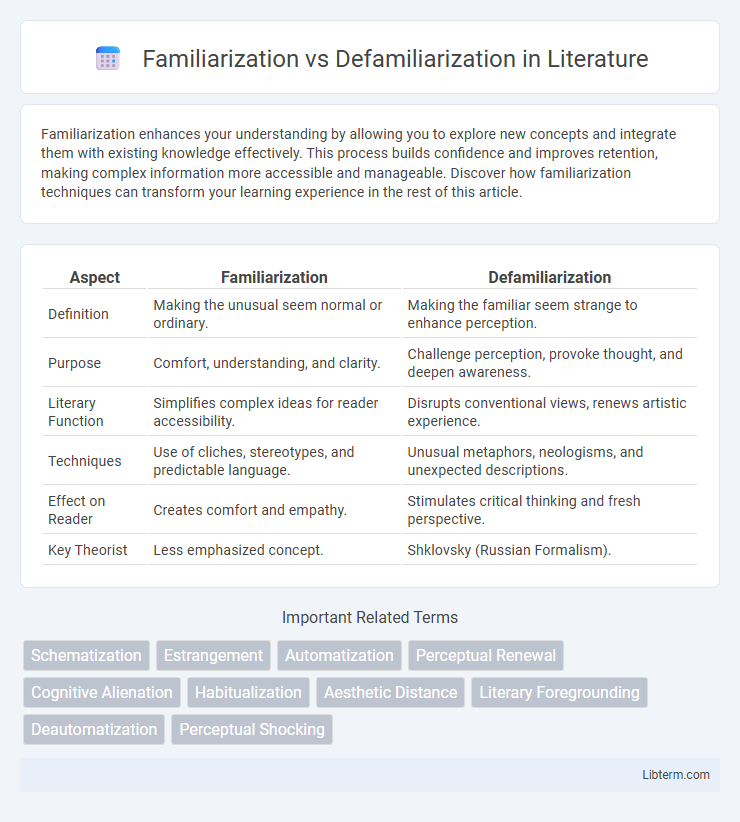Familiarization enhances your understanding by allowing you to explore new concepts and integrate them with existing knowledge effectively. This process builds confidence and improves retention, making complex information more accessible and manageable. Discover how familiarization techniques can transform your learning experience in the rest of this article.
Table of Comparison
| Aspect | Familiarization | Defamiliarization |
|---|---|---|
| Definition | Making the unusual seem normal or ordinary. | Making the familiar seem strange to enhance perception. |
| Purpose | Comfort, understanding, and clarity. | Challenge perception, provoke thought, and deepen awareness. |
| Literary Function | Simplifies complex ideas for reader accessibility. | Disrupts conventional views, renews artistic experience. |
| Techniques | Use of cliches, stereotypes, and predictable language. | Unusual metaphors, neologisms, and unexpected descriptions. |
| Effect on Reader | Creates comfort and empathy. | Stimulates critical thinking and fresh perspective. |
| Key Theorist | Less emphasized concept. | Shklovsky (Russian Formalism). |
Understanding Familiarization: Definition and Purpose
Familiarization involves the process of making information, concepts, or experiences more accessible and recognizable by connecting them to existing knowledge or common contexts. Its primary purpose is to enhance comprehension and ease of learning, enabling individuals to quickly grasp new ideas by relating them to familiar frameworks. This cognitive strategy reduces uncertainty and increases confidence, fostering a smoother transition from unfamiliar to familiar content.
What is Defamiliarization? Core Concepts Explained
Defamiliarization is a literary and artistic technique that disrupts ordinary perception by presenting familiar objects or ideas in an unfamiliar way to enhance awareness and critical engagement. Core concepts include estrangement, which forces audiences to see the commonplace from fresh perspectives, and cognitive dissonance, which challenges automatic responses and stimulates deeper thought. This method, pioneered by Russian Formalists like Viktor Shklovsky, emphasizes the creative use of language and form to refresh sensory experience and break habitual understanding.
Historical Origins of Familiarization and Defamiliarization
Familiarization traces its roots to everyday cognitive processes where repeated exposure to stimuli leads to recognition and ease of understanding, deeply rooted in classical rhetoric and educational practices aiming to reinforce known concepts. Defamiliarization originated in early 20th-century Russian Formalism, notably introduced by Viktor Shklovsky in 1917, as a literary technique designed to make common objects and language appear strange to renew perception and disrupt automatic recognition. These historical origins highlight a dichotomy where familiarization consolidates understanding through repetition, while defamiliarization challenges perception by unsettling habitual recognition patterns.
Key Differences Between Familiarization and Defamiliarization
Familiarization involves making information or concepts more accessible and easily understood by using common or relatable terms, enhancing clarity and comprehension. Defamiliarization, conversely, employs unconventional or obscure methods to present familiar subjects in a fresh, often challenging way, prompting deeper reflection and critical analysis. The key difference lies in familiarization's goal of ease and comfort versus defamiliarization's aim to disrupt normal perception and provoke critical thinking.
Psychological Impact: How Familiarization Shapes Perception
Familiarization enhances cognitive processing by reinforcing existing neural pathways, leading to quicker recognition and a sense of comfort in perception. This psychological impact reduces uncertainty and cognitive load, stabilizing emotional responses and fostering positive associations with familiar stimuli. Conversely, familiarization can limit creativity by narrowing attention to expected patterns, potentially diminishing openness to new information.
Defamiliarization in Literature and Art
Defamiliarization in literature and art involves presenting familiar objects or concepts in an unfamiliar or strange way to disrupt habitual perception and provoke deeper engagement. This technique, pioneered by Russian Formalists like Viktor Shklovsky, emphasizes making the ordinary appear extraordinary, compelling audiences to see the world anew. Defamiliarization challenges conventional narratives and aesthetic norms, enhancing creativity and critical thought through renewed sensory and intellectual experience.
Techniques to Achieve Familiarization
Techniques to achieve familiarization include repetitive exposure, contextual learning, and sensory engagement that reinforce recognition and understanding of subjects or environments. Utilizing analogies and relatable examples helps anchor new information within existing knowledge frameworks, enhancing comprehension. Interactive activities and consistent practice promote deeper cognitive connections, making unfamiliar concepts more accessible and manageable.
Effective Methods for Defamiliarization
Defamiliarization is an artistic technique that makes the familiar appear strange to enhance perception and critical thinking. Effective methods for defamiliarization include altering language through unusual syntax, embedding unexpected metaphors, and disrupting conventional narrative structures to create cognitive estrangement. These techniques challenge audiences to rethink assumptions and engage more deeply with content by breaking habitual patterns of interpretation.
Practical Applications in Daily Life and Education
Familiarization enhances everyday learning by making new information relatable through connecting it to existing knowledge, improving comprehension and retention. Defamiliarization encourages critical thinking and creativity by presenting concepts in unexpected ways, helping students challenge assumptions and develop problem-solving skills. In practical education, blending familiarization with defamiliarization techniques fosters deeper engagement and adaptive understanding, supporting lifelong learning.
Striking a Balance: The Interplay of Familiarization and Defamiliarization
Striking a balance between familiarization and defamiliarization enhances narrative engagement by blending recognizable elements with novel perspectives, enriching reader experience and comprehension. Familiarization grounds the audience through cultural or contextual references, while defamiliarization disrupts routine perception, prompting critical reflection and deeper thought. This interplay fosters dynamic storytelling that simultaneously comforts and challenges, optimizing cognitive and emotional resonance.
Familiarization Infographic

 libterm.com
libterm.com